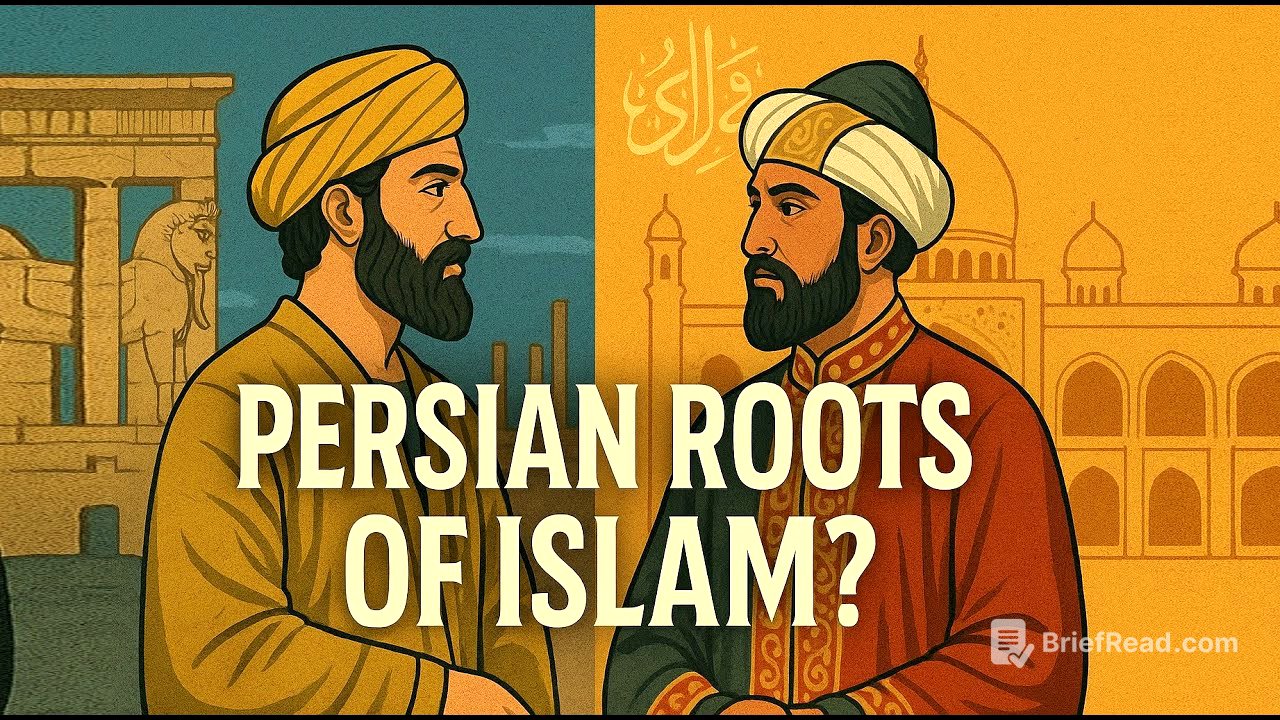TLDR;
This video explores the significant influence of Persian heritage on Islamic civilization, highlighting contributions in governance, language and literature, science and philosophy, architecture, and Islamic law and spirituality. It emphasizes how Persian traditions were absorbed and adapted by Islamic empires, shaping the Islamic world for centuries.
- Persian governance innovations like the satrapy system and the Diwan influenced Islamic administration.
- Persian scholars refined Arabic language and literature, contributing to works like "One Thousand and One Nights" and preserving Persian identity through literature like Ferdosi's "Shahnameh."
- Persian scholars advanced mathematics, astronomy, medicine, and technology during the Islamic Golden Age, with their discoveries influencing the Renaissance.
- Persian architectural designs, including the Iwan and muqarnas, became iconic elements of Islamic architecture.
- Persian scholars significantly contributed to Islamic law, Hadith compilation, philosophy, and mysticism, shaping the intellectual and spiritual legacy of the Muslim world.
Introduction [0:05]
The video introduces the profound impact of Persian heritage on Islamic civilization, noting that when Arab armies arrived in Persia in the 7th century, they encountered a sophisticated society with advancements in governance, philosophy, literature, and architecture. Rather than erasing Persian legacy, the Islamic world absorbed and built upon it. The video aims to uncover the Persian influence that shaped Islamic civilization and continues to inspire the world.
Persian Governance in Islamic Civilization [1:12]
The Persian tradition of governance was marked by efficiency and delegation, exemplified by the satrapy system established by Darius I, where provinces were governed by officials monitored by royal spies. This system influenced later empires, including the Islamic caliphates. The Abbasid caliphate adopted the Persian Diwan system for managing taxation and land records, with Persian scribes playing a crucial role in shaping the Islamic bureaucracy. The Barmach family, of Persian origin, became central to the Abbasid administration, with members serving as powerful viziers. Taxation under the Abbasids was also influenced by Persian legal frameworks, ensuring fair taxation and regulated land distribution. Furthermore, the Persians contributed significantly to infrastructure, with the Islamic empires adopting and improving upon the Persian royal road and postal relay system to facilitate trade, military movements, and communication.
Persian Language and Literature in the Islamic World [5:31]
Persian scholars played a key role in refining Arabic grammar, syntax, and lexicon when Arabic became the administrative and scholarly language of the Islamic world. The first major grammatical work of the Arabic language was authored by a Persian. Persians also contributed to the art of calligraphy, developing elegant styles like Nus and Nastalik. Persian scholars shaped the Arabic literary tradition by introducing new storytelling techniques and poetic meters. "One Thousand and One Nights" owes much to Persian storytelling traditions, incorporating moral lessons, political satire, and intricate plot structures. Ferdosi's "Shahnameh," written in Persian in the 10th century, preserved pre-Islamic Persian history and mythology, ensuring the survival of Persian identity, language, and history.
Persian Contributions to Science and Philosophy [8:46]
Persia was home to intellectual hubs like the University of Gondeshapur, which influenced the Islamic world in medicine, philosophy, and theology. In the 9th century, Baghdad became the intellectual heart of the Islamic world, with Persian scholars like Abu Bakr and Ibans Cena furthering the study of medicine and anatomy at the House of Wisdom. Alawarismi, often called the father of algebra, introduced the systemic study of equations and algorithms. Nasira Dinatusi's revision of Tolmy's geocentric model and Iban Alhan's work in optics also made important contributions. Persians and Arabs advanced technologies like paper making, windmills, and watermills. Persian works were translated and studied by European scholars, fueling the scientific revolution in the West.
Persian Architectural Influence [13:31]
Early Islamic architecture borrowed from Greco-Roman and Byzantine designs, but as the Islamic world grew, Persian traditions became more influential. The Abbasids embraced Persian architectural principles, with the design of Baghdad inspired by the Sasanian city of Gur. The Iwan, a vaulted hall open on one side, has Persian origins and was incorporated into mosques, madrasas, and palaces. The mukarnas, a form of decorative vaulting, is believed to have originated in northeastern Iran. The Abbasids adapted urban planning concepts from Persia, such as the circular design of Ferrosabad. Persian influence extended to construction materials and methods, including the use of mud brick, baked brick, and vaulting techniques.
Persian Scholars and Islamic Law [18:32]
Persian scholars significantly contributed to Islamic law, Hadith compilation, philosophy, and mysticism. Abu Hanifh Nman, of Persian descent, founded the Hanfi school of thought. All six canonical Hadith collections in Sunni Islam were compiled by Persian scholars. Abu Huh al-Razali transformed Islamic philosophy, challenging Greek-influenced rationalist thought and reaffirming the importance of spirituality in Islamic theology.









